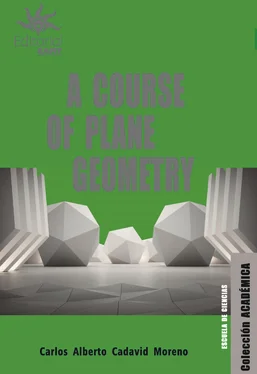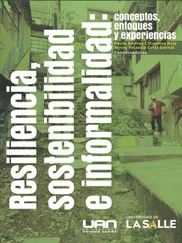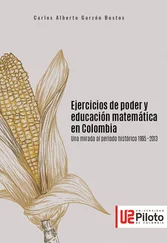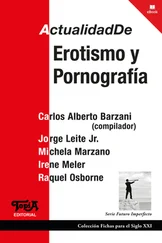Chapter 3introduces the notion of incidence geometry as a set together with a collection formed by some of its subsets, having three properties called axioms of incidence . Then examples of incidence geometries of various kinds are presented. Then the “main” examples of incidence geometries, namely the real cartesian plane, the hyperbolic plane and the elliptic geometry, are presented in complete detail. In particular, complete proofs, based only on the properties of addition and multiplication in the real number system, that the three axioms of incidence hold in these examples, are supplied. After this the subject of parallelism of lines is discussed, and an additional axiom, called Playfair’s axiom is studied. Playfair’s axiom is a refined version of Euclid’s fifth postulate. The chapter ends with a long discussion of how paralllelism behaves in all the examples of incidence geometries previously given. It is of particular importance the discussion of the behaviour of parallelism in the real cartesian plane, the hyperbolic plane and the elliptic geometry. It is shown that in the real cartesian plane, given any point A and any line l , with A not in l , there exists a unique line passing through A and being parallel to l ; that in the hyperbolic plane, given any point A and any line l , with A not in l , there exists an infinite number of lines passing through A and being parallel to l ; and that in the elliptic geometry, given any point A and any line l , with A not in l , there is no line passing through A and being parallel to l .
Chapter 4treats the formalization of the notion that one point is between two other points, i.e., the concept of a betweenness structure for an incidence geometry. A betweenness structure is defined as a collection of ordered triples of points of the plane, having four properties called the betweenness axioms . We remark that the realization by Hilbert that one of the main deficiencies of Euclid’s axiomatics, making some of Euclid’s proofs in the Elements ultimate dependant on pictures, lied in the lack of axioms governing betweenness, constitutes perhaps his main contribution for saving Euclid’s work. The chapter begins with the definition of betweenness structure for an incidence geometry. This structure makes it possible to define segments, triangles and the convexity of a subset of the plane. Then it is shown that a line l divides the plane minus l into two parts, called sides of the plane divided by l ; and also that a point A of a line l , divides l minus { A } into two parts, called the sides of l divided by A . As consequences the following interesting facts are proved to hold in any incidence geometry equipped with a betweenness structure, namely, that the endpoints of a segment are entirely determined by the segment, that each line is formed by an infinite number of points, and that there is a point between any two given points. Next, the important notion of ray is introduced, and a long theorem containing a bunch of facts about rays which prove very useful for the rest of the book, is stated and proved. Then the fundamental notion of angle is introduced, followed by a discussion of the important notion of interior of an angle. An important result called Crossbar Theorem is then presented at length. The chapter ends with a discussion of the usual betweenness structures carried by the real cartesian plane and the hyperbolic plane. Elliptic geometry is abandoned at this point for the rest of the book, due to the fact that it does not admit any betweenness structure. It does admit a modified betweenness structure though (see [2]).
Chapter 5introduces the notion of structure of congruence of segments for an incidence geometry equipped with a betweenness structure. It is defined as a collection of ordered pairs of segments, having three properties called axioms of congruence of segments . Then a useful result, called subtraction of segments, is proven. Next, the notion that a segment is less than another segment, is introduced, and its main properties are stated and proven, using subtraction of segments as the main tool. The rest of the chapter is devoted to define the usual congruence of segment structures in the real cartesian plane and in the hyperbolic plane, and proving that these satisfy the three axioms.
Chapter 6is dedicated to the notion of a structure of congruence of angles for an incidence geometry equipped with a betweennes structure and a congruence of segments structure. It is defined as a collection of ordered pairs of angles, having three properties called axioms of congruence of angles . This structure allows for the defintion of congruence of triangles. Then the concepts of adjacent angles, supplementary angles and vertical angles are defined. The important results summarized as “angles which are supplementary of congruent angles, are congruent”, “a pair of adjacent angles which are congruent to a pair of supplementary angles, are supplementary” and “vertical angles are congruent”, are precisely stated and proved. Then the angle addition theorem and the angle subtraction theorem are discussed. The notion of an angle being less than another angle is introduced, and its main properties are proven. Right angles are then defined as angles which are congruent to any of its (two) supplementary angles, and the congruence of any two right angles is established. The study of the usual structures of congruence of angles for the real cartesian plane and the hyperbolic plane occupy the rest of the chapter.
Finally, Chapter 7is dedicated to Hilbert Planes. Hilbert Planes are incidence geometries equipped with a betweenness structure, a congruence of segments structure and a congruence of angles structure. This requires that a total of thirteen axioms are satisfied, three incidence axioms, four betweenness axioms, three congruence of segments axioms and three congruence of angles axioms. The main examples of Hilbert Planes are the real cartesian plane and the hyperbolic plane. The rest of the chapter is dedicated to the study of Book I of Euclid’s Elements, a la Hilbert.
1.5 How to study this book
Your attitude, in order to really grasp the material, should be that of a hyperactive student. Leisurely studying the material will not do it! Read every sentence carefully. Read the examples and do as many exercises as possible. You may even try to create some exercises. In a first reading of the book, you may skip certain particularly long examples, like the one on parallelism in the hyperbolic plane.
Конец ознакомительного фрагмента.
Текст предоставлен ООО «ЛитРес».
Прочитайте эту книгу целиком, купив полную легальную версию на ЛитРес.
Безопасно оплатить книгу можно банковской картой Visa, MasterCard, Maestro, со счета мобильного телефона, с платежного терминала, в салоне МТС или Связной, через PayPal, WebMoney, Яндекс.Деньги, QIWI Кошелек, бонусными картами или другим удобным Вам способом.












